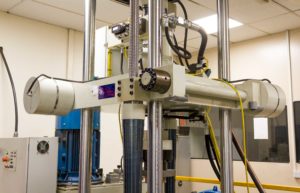Eric Sonahee, design and development engineer at steering system manufacturer Pailton Engineering, explains why understanding the usage conditions is crucial to a development process.
Military, emergency and commercial vehicles encounter many extreme conditions across their lifespan. From the varying passenger weight that a bus has to contend with, to the rough terrain a military vehicle may face, there is a lot that can go wrong.
Steering systems must therefore be engineered to take on such extremes. This begins at the design stage and ends with analysis through testing. It’s here the parts are tested to their limits and validated against the original specification and real life requirements.
Testing of steering systems is primarily about replicating as near to the same conditions that would be encountered on the road. Theoretical testing using calculations is a good start, but nothing gets closer to reality than physical testing. Using an on-site test facility with purpose built test rigs, it is possible to test a sub-assembly of the entire steering system, presenting the whole structure with like for like conditions that match the final application.
One of the most important parameters to test is the maximum load. With this information we can observe how much force a part can endure, in both tensile and compression, before a failure occurs. At Pailton Engineering, we have different rigs to test a range of force applications, our highest being ±400kN, which is capable of applying static and dynamic loads.
Applying a large force a few times isn’t representative of the actual conditions a vehicle will encounter during its entire lifetime. Working loads seen in harsh environments can be just as detrimental to a part’s life as the peak loads. We therefore incorporate the two in order to see how different force affects the part dynamically.

Using customer data
Moreover, with enough information from our customers, we are able to compile a multitude of loads at their respective frequencies and cycles as part of a block program. This program effectively mirrors the real-life data that is gathered from the vehicle. It’s here that we can accurately assess the true fatigue life of the part.
With a variety of loads and frequencies in place, it is also important to measure the number of cycles that the parts can endure over time. A typical test at Pailton can perform 1,000,000 cycles in only one week. That’s enough to replicate infinite life for a part on a vehicle. After all, these vehicles are expected to last for many years with minimal maintenance. By obtaining this figure you can determine the part’s lifecycle management as part of ongoing maintenance.
Saving people
Ambulances are large vehicles that contend with congested roads and time-sensitive situations. While their mileage may not match the likes of trucks and other commercial vehicles, the drivers are dependent on agile steering, as they manoeuver past cars at high speeds.
In the testing stages of emergency vehicle steering systems, understanding factors like the maximum weight capacity of the vehicle, including equipment and people, is vital in ensuring the testing is valid and appropriate for the application.
Protecting people
As well as operating at high-speed, military vehicles are often required to operate in extreme terrain and conditions. They must also be able to cope with a multitude of scenarios, including deep water wading.
To successfully navigate through water, the components underneath the vehicle must be completely sealed off to external elements to keep dust, grit and salt out of components, and lubrication in.
This is where environmental testing comes in. For applications like this, this testing is arguably just as important as the physical testing. It is vital that every part of the steering system is able to handle water exposure, changes to temperature and humidity variance.
Moving people
Passenger vehicles undertake long journeys subject to inclement weather and varying weights. The validation process should test against these daily occurrences as well as irregular incidents such as curb strikes and potholes.
Additionally, as the driver enters the vehicle and starts their shift, they often use the steering wheel for stability. This means that the steering column has to handle a regular transverse load. To make sure the steering column can manage this, we have a whole test rig dedicated to testing the effects of driver entry.
Like buses, commercial vehicles carry out long journeys, in turbulent weather while carrying varying loads. Commercial vehicle steering systems therefore need to be designed and manufactured with this variance in mind.
Commercial vehicles working in sub-zero temperatures in countries such as Canada will undoubtedly have different needs from those in hot climates such as the Middle East or Australia, and we take this into account from day one of the design process, right through to thermal durability testing.
Regardless of the type of vehicle being designed, having a sound knowledge of the conditions affecting it either on the road, or in off-road conditions, enables valid and appropriate testing. Work with your steering supplier to make sure your vehicles are equipped with rigorously tested systems. There’s certainly no need to reinvent the steering wheel, despite it being over 120 years old.


